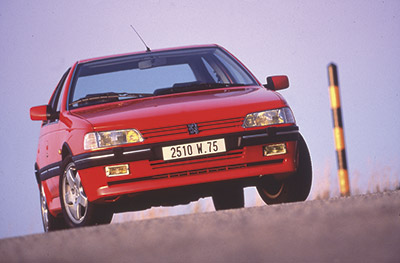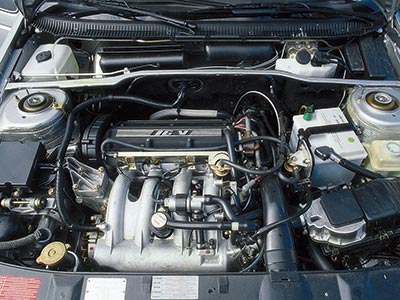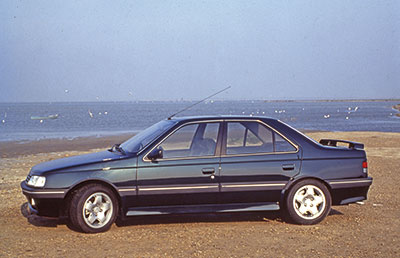-
MenuBack
-
COLLECTIONS
-
-
24h00 Le Mans
-
Alpine A110 1600S
-
Lancia 037
-
-
-
FULL KIT
-
-
FULL KIT
-
-
- ACCESSORIES
- Australian
- MAQMADON
-
Assembly guides
-
-
Blog Ixo
-
- FAQ
The Peugeot 405 Mi 16
Although it did not have the aura of the little 205 GTI bomb created three years earlier, the 405 Mi 16 saloon soon proved to be an accomplished sports car. Under the auspices of Peugeot Talbot Sport, it distinguished itself in Supertourism, while a Turbo 16 version masterfully won the Rallye-Raid for three consecutive seasons. In 1989, an all-wheel drive version was launched and in 1992, the Phase 2 was launched.
Barely three months after the presentation of its new 405, Peugeot once again showed its claws and offered the sporty Mi16 version. The name of this high-performance, homogeneous model came from the multi-valve cylinder head fitted to its engine, which was a first for a French production car, shared with the Citroën BX GTI which was launched at the same time. Peugeot's objective at the end of the 1980s was to rejuvenate its customer base, but also to confirm the sporting experience acquired by the 205 GTI. Moreover, to disturb the German saloon cars which usually dominate this category was certainly part of the commercial projects of the Sochaux-based brand at the time...

The 405 Mi 16, Peugeot's other big number, is a sort of Super 205 GTI.
© IXO Collections SAS - Tous droits réservés. Crédits photo © Peugeot
Design by Pininfarina
In the summer of 1987, the French manufacturers Peugeot, Citroën and Renault unveiled their new sports saloon cars, called the 405 Mi 16, the BX GTI 16 Soupapes and the 21 Turbo respectively. With its bodywork designed in collaboration with Pininfarina, the brand's historic Italian stylist, the Mi16 immediately stands out. It manages to be soberly elegant without overloading its original lines with flashy sporty accessories and equipment. The only external concessions made to the sporty world are a front spoiler, lower body rails and a rear spoiler, as well as 14-inch alloy wheels (which will be upgraded to 15-inch from 1989). One of the strengths of the 405 Mi16 is its particularly well-balanced and efficient running gear. Its handling is reminiscent of the agility of the 205 GTI, but in a more precise and rigorous way thanks to a longer wheelbase. The cabin is equipped with a sporty layout, including an instrument panel with numerous dials, a three-spoke leather-wrapped steering wheel and bucket seats.

With its 160 hp (84 hp/litre!), the 1.9 litre 16-valve engine is one of the most powerful French sports engines of the moment.
© IXO Collections SAS - Tous droits réservés. Crédits photo © Peugeot
Multi-valve engine
Contrary to its competitor Renault, which has been experimenting with turbocharged engines for the last ten years in competition, PSA remains faithful to the naturally-aspirated GTI engine which has been so successful up to now. Thus, under the bonnet of the Peugeot 405 Mi 16, we find the four-cylinder Type XU9-JA which already equips the 205 GTI 1.9 and the 309 GTI. But for the occasion, the block is topped by a 16-valve magnesium cylinder head, a legacy of the 205 Turbo 16 world rally champion. Now equipped with a double overhead camshaft and hydraulic tappets for automatic valve lash adjustment, the engine is now 30bhp more powerful, offering 160bhp at 6,500rpm and a maximum torque of 18.4mkg at 5,000rpm. The XU9-JA has a reinforced crankcase, removable liners and forged steel connecting rods, while the elegant exhaust manifold has eight pipes. Injection and ignition management is provided by a Bosch Motronic ML 4-1 system. The gearbox is the one already adopted by the 205 and 309 GTI, but with a new 5-speed calibration.

Only a few aerodynamic accessories such as the rear spoiler distinguish the Mi 16 from the basic version.
© IXO Collections SAS - Tous droits réservés. Crédits photo © Peugeot
Model developments
Thus equipped, the Peugeot 405 Mi 16 can reach a top speed of 220 km/h and can accelerate from zero to 100 km/h in 8.6 seconds, as well as complete the 400 metre standing start in 16 seconds. ?In the spring of 1989, on the strength of its victories in the Paris-Dakar Rally, Peugeot presented a permanent four-wheel drive version of the 405 Mi 16, fitted with a Torsen differential. Unfortunately, this Mi 16 with all-wheel drive was not as successful as expected, falling victim to its 200 kg extra weight. In 1992, the bodywork was 'restyled' for the new Phase 2. The 1,998 cc (86 mm bore x 86 mm stroke) Type XU10 J4/LZ engine was fitted, but with the catalytic converter now compulsory, power output fell to 155 bhp, then 150 bhp in 1994. Compared to its new competitors, the 405 Mi16 was considered more as a high-performance tourer than a real sports car and its career was interrupted in July 1995. In November 1993, in order to celebrate the victory of the Peugeot 905 in the 24 Hours of Le Mans, a limited series of 500 units, called Le Mans, was marketed, in red only.

The 405 Mi 16 is a true sports car that is also comfortable and spacious, which is an additional selling point.
© IXO Collections SAS - Tous droits réservés. Crédits photo © Peugeot
Share this post





 Français
Français Anglais
Anglais Allemand
Allemand Espagnol
Espagnol Italien
Italien Portugal
Portugal